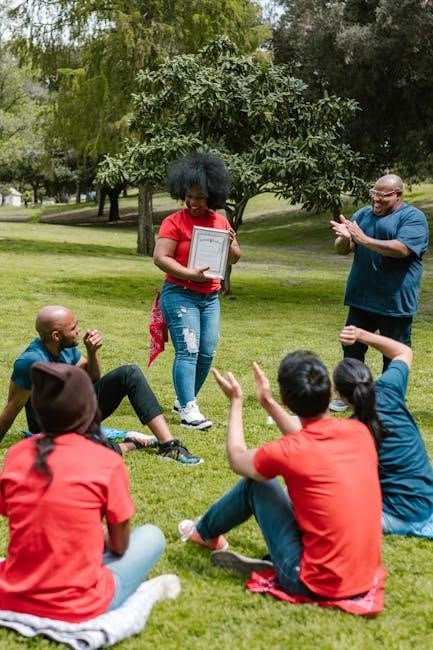Total Participation Techniques (TPTs) are innovative strategies designed to engage every student in the classroom‚ ensuring active learning and higher-order thinking. These techniques move beyond traditional lecture-style teaching‚ offering teachers alternative ways to involve all students. The core idea of TPTs is to create a learning environment where every student is actively participating‚ providing evidence of their engagement and understanding. Developed by educators Pérsida and William Himmele‚ TPTs emphasize the importance of student-centered instruction. By using these methods‚ teachers can maximize learning opportunities and ensure that no student is left disengaged. TPTs are particularly effective in fostering collaboration‚ critical thinking‚ and creativity‚ making them a valuable tool in modern education.
Definition and Overview of TPTs
Total Participation Techniques (TPTs) are a collection of innovative‚ research-based strategies designed to engage all students in the classroom simultaneously. These techniques ensure that every student is actively involved in the learning process‚ fostering higher-order thinking‚ collaboration‚ and accountability. Developed by educators Pérsida Himmele and William Himmele‚ TPTs are rooted in the belief that every student has the potential to contribute meaningfully to the learning environment when given the right opportunities.
TPTs are not merely activities but a systematic approach to teaching that ensures all students are engaged‚ challenged‚ and heard. They are designed to move beyond the traditional “stand and deliver” lecture style‚ where only a few students actively participate. Instead‚ TPTs create a dynamic and inclusive classroom culture where every student’s voice and ideas are valued. By using these techniques‚ teachers can assess student understanding in real-time‚ identify gaps in knowledge‚ and adjust instruction accordingly.
The cornerstone of TPTs is the idea that participation is not optional. Every student is expected to contribute‚ whether through verbal responses‚ written reflections‚ or collaborative discussions. This approach not only enhances student engagement but also helps teachers gather evidence of learning. For example‚ techniques like “The Ripple” or “Write-Arounds” allow teachers to see how students are processing information and applying concepts. These methods also encourage students to think critically and creatively‚ preparing them for the complexities of the modern world.
TPTs are highly flexible and can be adapted to suit various grade levels‚ subject areas‚ and classroom settings. They are particularly effective in diverse classrooms‚ where students may have different learning styles‚ languages‚ or cultural backgrounds. By incorporating TPTs‚ teachers can create a sense of community and shared responsibility‚ breaking down barriers and ensuring that no student feels isolated or disengaged.

The Himmeles emphasize that TPTs are not just about keeping students busy but about ensuring that every student is intellectually engaged. These techniques are grounded in educational research‚ which highlights the importance of active learning in improving academic outcomes. By requiring all students to participate‚ TPTs help teachers identify and address misconceptions‚ reinforce key concepts‚ and promote deeper understanding.
Importance of TPTs in Modern Education
In today’s fast-evolving educational landscape‚ Total Participation Techniques (TPTs) have emerged as a vital tool for educators seeking to create engaging‚ inclusive‚ and effective learning environments. These techniques are not just a passing trend but a response to the growing need for innovative strategies that address the diverse needs of modern students. The importance of TPTs lies in their ability to foster active learning‚ promote equity‚ and ensure that every student is intellectually engaged‚ regardless of their background or learning style.
One of the most significant benefits of TPTs is their emphasis on active learning. In contrast to traditional teaching methods‚ which often focus on passive reception of information‚ TPTs require students to actively participate in the learning process. This approach aligns with research that shows active learning enhances retention‚ critical thinking‚ and problem-solving skills. By engaging all students simultaneously‚ TPTs ensure that no one is left disengaged or unchallenged. Techniques like “The Ripple” or “Write-Arounds” encourage students to think deeply about content and share their ideas‚ creating a dynamic and interactive classroom environment.
TPTs also play a crucial role in promoting equity in education. In many classrooms‚ only a small subset of students actively participate‚ often leaving others feeling marginalized or disengaged. TPTs help bridge this gap by providing opportunities for every student to contribute. Whether through verbal responses‚ written reflections‚ or collaborative discussions‚ these techniques ensure that all voices are heard. This inclusivity is particularly important in diverse classrooms‚ where students may have different cultural backgrounds‚ languages‚ or learning abilities. By valuing every student’s perspective‚ TPTs help create a sense of belonging and shared responsibility for learning.
Another key advantage of TPTs is their ability to provide real-time feedback on student understanding. Traditional teaching methods often rely on summative assessments‚ which only provide a snapshot of student learning after instruction has taken place. In contrast‚ TPTs allow teachers to assess student comprehension during the lesson‚ enabling them to adjust instruction on the fly. For example‚ if a teacher notices that many students are struggling with a particular concept during a TPT activity‚ they can address the issue immediately‚ rather than waiting until the end of the lesson or unit. This immediate feedback loop is essential for meeting the needs of all learners and ensuring that no student falls behind.
TPTs are also aligned with the broader goals of modern education‚ which emphasize preparing students for the challenges of the 21st century. In today’s world‚ students need to be able to think critically‚ collaborate effectively‚ and communicate clearly. TPTs help develop these skills by encouraging students to work together‚ share ideas‚ and engage in meaningful discussions. For instance‚ techniques like “Numbered Heads Together” or “Chalkboard Splash” promote collaboration and problem-solving‚ while also fostering a sense of accountability among students. By teaching students to work together and support one another‚ TPTs help prepare them for the collaborative nature of the modern workplace.
Furthermore‚ TPTs are highly adaptable to different teaching contexts. Whether in a small‚ rural classroom or a large‚ urban school‚ these techniques can be modified to meet the unique needs of the students and teacher; The Himmeles emphasize that TPTs are not a one-size-fits-all approach but rather a flexible toolkit that educators can tailor to their specific classroom environments. This adaptability makes TPTs a valuable resource for teachers working in a wide range of settings‚ from elementary to high school and beyond.
In addition to benefiting students‚ TPTs also support teacher professional growth. By using these techniques‚ educators gain insights into how students learn and think‚ which can inform their instruction and improve student outcomes. TPTs also encourage teachers to think creatively about their lessons and explore new ways to engage students. This shift from traditional teaching methods can lead to increased job satisfaction and a renewed sense of purpose among educators.

Foundational Concepts of Total Participation Techniques
Total Participation Techniques (TPTs) are rooted in the belief that every student deserves to be actively engaged in the learning process. These techniques are designed to ensure that all students are mentally and physically involved in lessons‚ fostering a classroom environment where no one is passive. The cornerstone of TPTs is the idea that active participation leads to deeper understanding and retention of material. By incorporating strategies like “The Ripple” and “Think-Pair-Share‚” teachers can create opportunities for every student to contribute‚ whether through verbal responses‚ written reflections‚ or collaborative discussions. TPTs also emphasize the importance of higher-order thinking‚ encouraging students to analyze‚ evaluate‚ and create rather than simply recall information. This approach ensures that learning is dynamic‚ inclusive‚ and meaningful for all students.
The Ripple Effect in Classroom Engagement
The Ripple Effect is a cornerstone concept within Total Participation Techniques (TPTs)‚ designed to foster classroom engagement and ensure that every student is actively involved in the learning process. This approach is rooted in the idea that when a few students share their thoughts or ideas‚ it creates a wave of engagement that spreads throughout the entire class. The Ripple Effect is particularly effective because it allows teachers to gauge student understanding in real-time while encouraging participation from even the most reluctant learners.
At its core‚ the Ripple Effect involves selecting a small group of students to share their responses to a question or prompt. These students act as “ripple starters‚” providing insights that can be built upon by their peers. For example‚ a teacher might ask a question and then call on two or three students to share their thoughts. These initial responses create a “ripple” that encourages other students to contribute‚ either by agreeing‚ disagreeing‚ or expanding on the ideas presented. Over time‚ this approach helps to create a culture of collaboration and active participation in the classroom.
The Ripple Effect is highly effective because it addresses the common challenge of disengagement in traditional classroom settings. In many classrooms‚ only a handful of students actively participate in discussions‚ while others remain passive. By using the Ripple Effect‚ teachers can ensure that every student has the opportunity to engage with the material‚ even if they do not initially volunteer to speak. This technique also helps to build confidence among shy or hesitant students‚ as they see their peers contributing and feel more comfortable doing the same.
Key Benefits of the Ripple Effect
- Increased Engagement: The Ripple Effect ensures that all students are mentally and sometimes physically involved in the lesson‚ reducing the likelihood of disengagement.
- Higher-Order Thinking: By encouraging students to build on one another’s ideas‚ the Ripple Effect promotes critical thinking‚ analysis‚ and creativity.
- Formative Assessment: Teachers can use the Ripple Effect to assess student understanding in real-time‚ identifying areas where students may need additional support.
- Inclusivity: This technique creates a sense of community in the classroom‚ ensuring that every student feels valued and heard.
Implementing the Ripple Effect
Implementing the Ripple Effect in the classroom is straightforward and can be adapted to suit various teaching styles and subject areas. Teachers can begin by posing an open-ended question or prompt that requires critical thinking. They then select a small group of students to share their responses. These students might write their thoughts on sticky notes‚ share them aloud‚ or contribute digitally using tools like Socrative or Google Jamboard. Once the initial “ripple” has been created‚ the teacher can invite other students to add their thoughts‚ either individually or in small groups.
One of the key advantages of the Ripple Effect is its flexibility. Teachers can use this technique at any point in the lesson‚ whether they are introducing a new concept‚ reviewing material‚ or preparing students for an assessment. For example‚ during a science lesson on photosynthesis‚ a teacher might ask students to explain the role of chlorophyll. A few students might share their answers‚ and then the teacher could ask the class to build on these responses‚ discussing the importance of sunlight‚ water‚ and carbon dioxide.
Real-World Applications
The Ripple Effect is not limited to academic discussions. It can also be used to encourage participation in other areas of classroom life‚ such as brainstorming sessions‚ problem-solving activities‚ or even classroom discussions about behavior and expectations. For instance‚ a teacher might use the Ripple Effect to gather students’ ideas for classroom rules or to discuss strategies for resolving conflicts. By involving all students in these conversations‚ teachers can create a sense of ownership and responsibility among their learners.
Active Learning and Its Role in TPTs
Active learning is a fundamental pillar of Total Participation Techniques (TPTs)‚ serving as a dynamic approach to engage students in the learning process. Unlike traditional teaching methods that often rely on passive listening‚ active learning encourages students to actively participate in activities that promote deeper understanding and retention of material. Within the framework of TPTs‚ active learning is not merely a supplementary strategy but a central component that ensures every student is mentally and sometimes physically engaged in the lesson.
The concept of active learning is rooted in the belief that students learn best when they are actively involved in constructing their own knowledge; This approach contrasts with passive learning‚ where students are mere recipients of information. In active learning environments‚ students are encouraged to think critically‚ solve problems‚ and collaborate with peers‚ all of which are essential skills for success in the 21st century. TPTs embrace this philosophy by providing teachers with a variety of strategies to make active learning a reality in their classrooms.

The Role of Active Learning in TPTs
Active learning plays a pivotal role in TPTs by creating opportunities for students to engage with the material in meaningful ways. One of the primary goals of TPTs is to ensure that every student is an active participant in the learning process. This is achieved through techniques that require students to think‚ reflect‚ and share their ideas‚ either individually or in groups. By incorporating active learning into TPTs‚ teachers can create a more dynamic and inclusive classroom environment where all students feel valued and challenged.
Active learning within TPTs is characterized by its focus on higher-order thinking skills‚ such as analysis‚ synthesis‚ and evaluation. These skills are essential for students to fully grasp complex concepts and apply them in real-world contexts. For example‚ a teacher using TPTs might ask students to solve a problem or complete a task that requires them to apply what they have learned. This approach not only reinforces understanding but also helps students develop the critical thinking skills they need to succeed in an increasingly complex world.
Specific Techniques That Promote Active Learning in TPTs

TPTs offer a wide range of strategies that teachers can use to promote active learning in the classroom. One such technique is “Think-Pair-Share‚” where students first think about a question or problem individually‚ then discuss their thoughts with a partner‚ and finally share their ideas with the entire class. This technique encourages collaboration and ensures that every student has the opportunity to contribute to the discussion.
Another technique is the use of “Exit Tickets‚” where students write down their thoughts or questions about the lesson as they leave the classroom. This strategy not only provides teachers with valuable feedback but also gives students a chance to reflect on what they have learned. By incorporating these types of activities into their lessons‚ teachers can create a more engaging and interactive learning environment that aligns with the principles of TPTs.
Benefits of Active Learning in TPTs
The integration of active learning into TPTs offers numerous benefits for both students and teachers. For students‚ active learning increases engagement and motivation‚ leading to a more enjoyable and effective learning experience. It also helps students develop important skills‚ such as communication‚ collaboration‚ and problem-solving‚ which are essential for success in both academic and professional settings.
For teachers‚ active learning provides a way to assess student understanding in real-time‚ allowing for immediate adjustments to instruction. This approach also helps to create a more inclusive classroom environment‚ where every student feels valued and has the opportunity to contribute. By incorporating active learning into their teaching practices‚ teachers can ensure that their students are not only learning but also growing as individuals.
Challenges and Solutions

While active learning offers many advantages‚ it can also present challenges for teachers who are new to TPTs. One common challenge is managing classroom dynamics‚ particularly when introducing new techniques that require students to work in groups or share their ideas publicly. To address this‚ teachers can start with simple activities that gradually build students’ confidence and comfort with active learning.
Another challenge is ensuring that all students are fully engaged and participating; Some students may be hesitant to share their thoughts‚ especially in the early stages of implementing TPTs. To overcome this‚ teachers can create a supportive classroom culture that encourages participation and respects diverse perspectives. By doing so‚ they can help all students feel comfortable contributing to the learning process.
Active learning is a vital component of Total Participation Techniques‚ playing a central role in creating engaging and effective learning environments. By incorporating active learning into their teaching practices‚ educators can ensure that every student is an active participant in the learning process‚ leading to greater engagement‚ deeper understanding‚ and the development of essential skills. As teachers continue to explore and implement TPTs‚ the integration of active learning will remain a cornerstone of their efforts to create classrooms where every student thrives.